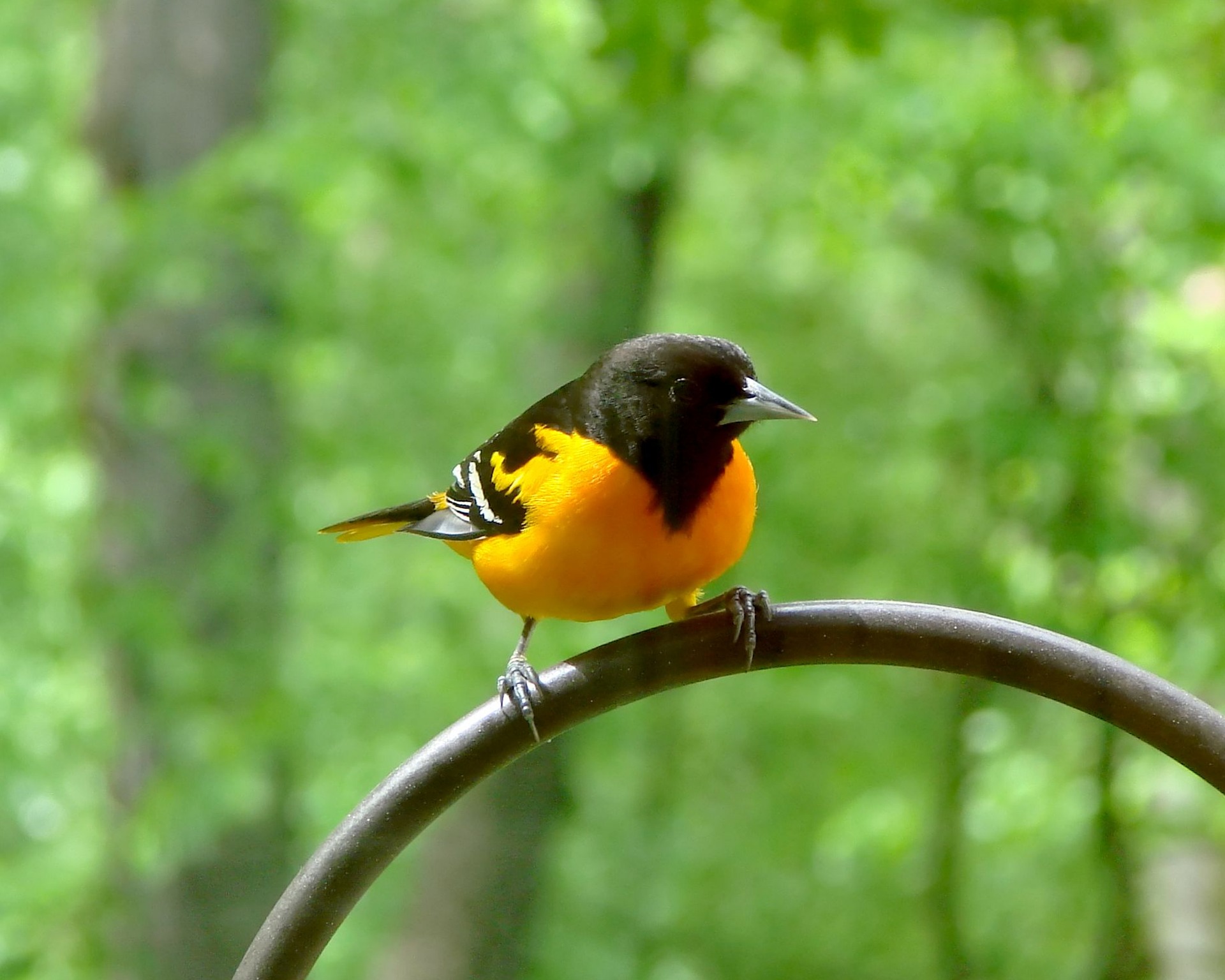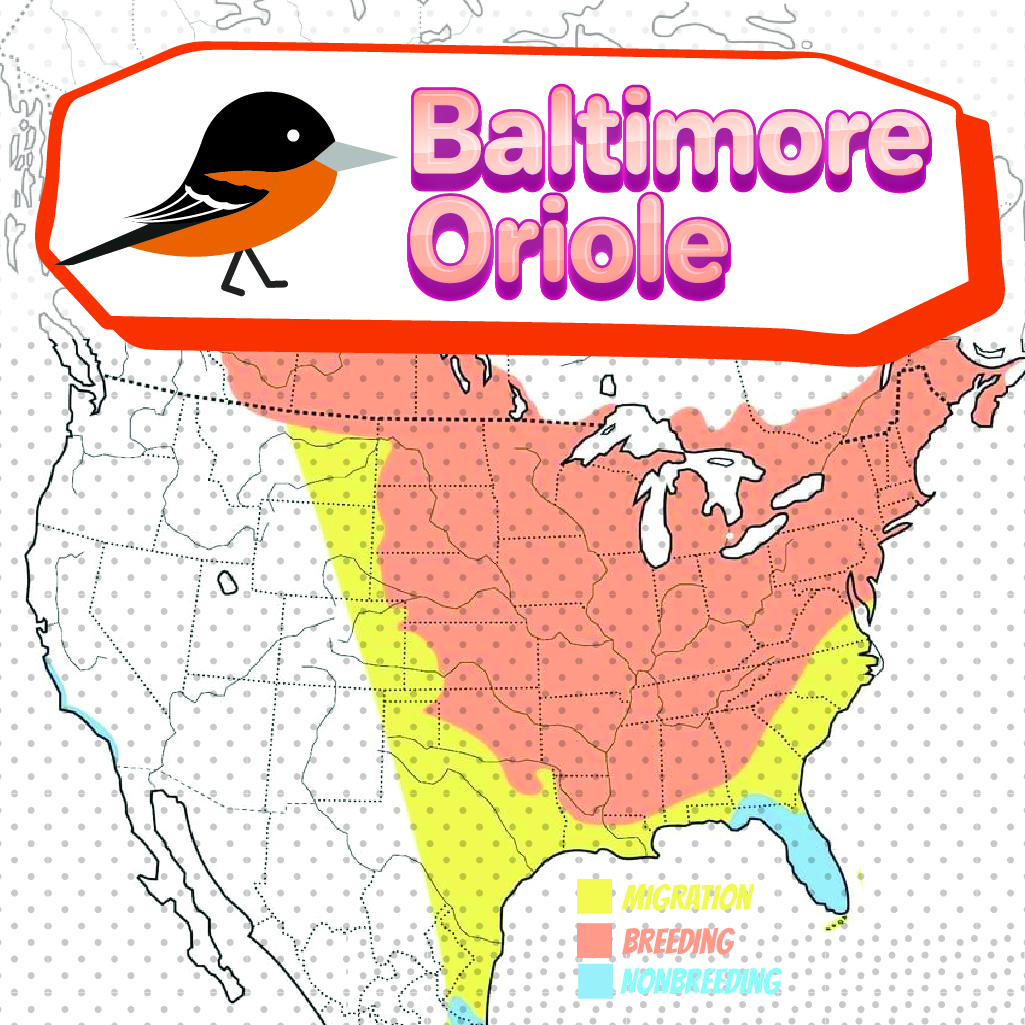
A Baltimore Oriole is a fun bird to see while bird watching. Below are some tips to help you identify Baltimore Orioles. We have also put together a list of fun Baltimore Oriole t-shirts, Baltimore Oriole bird patches, bird houses, bird feeders, binoculars, stickers and other fun bird watching items.
About Baltimore Orioles
The Baltimore Oriole is mostly found in home backyards and parks, whistling from treetops in the eastern part of North America. Males have an orange brilliance that blazes like a torch from high branches. Females spend most of the time weaving their handing nest. They are easily lured into bird feeders because of their fondness for fruits and nectar.
Baltimore Oriole Color Pattern
Males are flame-orange and black, with black compact heads and black wings with white streaks. Immature males look similar to females with yellow-orange breasts and grey heads and backs. They have only two white stripes on their wings.
Description and Identification
Baltimore Orioles are small birds that have a pointed beak and long tail feathers. The adults sport white bars on their dark wings. They have a sturdy body with long longs. The males and females are different in size and color with the males being slightly bigger. It is easy to distinguish between the sexes. Parts of the males’ shoulder and rump are brightly colored orange or yellow while the rest of the plumage is black. The females, on the other hand, are more lightly colored with brownish-orange feathers and a dull yellow shade on the underside of the belly. The juvenile male birds resemble the females of the species and take about two years to gain more colorful plumage.
Baltimore Oriole Size
Baltimore Orioles are medium in size with compact bodies and thick necks. They have long pointed bills which is a hallmark of the blackbird family. Adults are between 17 and 19 centimeters longs and weigh between 30 and 40 grams. They have a wingspan of 23-30 centimeters.

Baltimore Oriole Behavior
Baltimore Orioles comb the high branches in search of insects, flowers, and fruits. They are energetic in foraging as they hang upside down from twigs and flutter to maximize their reach. With their impressive agility, they tend to jump and catch flying insects from the air. Orioles protect only the areas around their nests, unlike many other birds. During courting, the male hops about the female bowing and extending his wings to show his back.
Baltimore Oriole Diet
Baltimore Orioles feed on a wide range of food. They consume insects, berries, and nectar with varying frequencies. These birds are particularly fond of Forest Tent Caterpillar moth larvae which are considered a pest in orchards and gardens. The birds extract the outer hair on these caterpillars by scraping them against a branch before eating them. Baltimore Orioles are also picky eaters who choose only the darkest and most ripe berries. They stab the fruits with their closed beak and then tear a gash from which they drink the juice. This strange feeding behavior is called gaping.
They mainly eat fruits, nectar, and insects including beetles, grasshoppers, and small invertebrates. They are known to damage whole fruit crops and may be considered by most fruit growers as pests.
Baltimore Oriole Habitat
Baltimore Orioles occupy the topmost canopies of dense deciduous trees. They prefer open woodlands to deep forests and can be found occupying partially wooded regions along rivers and wetlands. These birds can also breed in many secondary habitats like farmlands that don’t strictly adhere to their natural settings. Urbanization has not impacted these birds as much and they can be found in moderate cityscapes that have enough tree cover and foliage. They have also been spotted adapting to shaded coffee estates and orchards in Mexico.
Baltimore Orioles’ breeding grounds are in the eastern and east-central North America high in the deciduous forests. They prefer open woodlands near water sources and river banks. They have adapted well to the human population where they can be seen feeding in parks.
Range and Migration

Baltimore Orioles are commonly found in Eastern North America. During the summer it occupies most of the Canadian Prairies and ranges across the United States to Central Mississippi and Georgia in the south. They are typically found in Central and South-Eastern America. These orioles can be found in some places across the south of the U.S. throughout the winter as well. Come the colder seasons, they migrate to more tropical locations near the equator and can be found as far as Mexico. Its range overlaps with that of the Bullock’s Oriole and the two are often confused together. Baltimore Orioles rarely, if ever, are found on the European continent and they are predominantly mainland American birds.
Nesting
Baltimore Orioles have an intricately built pouch made of improvised plant and animal materials. It is usually found hanging on the edge of the branches of elms, willows, maples, or apple trees. They can also anchor the tightly woven nests on vertical tree trunks. These nests are found 6 to 90 feet above the ground. The females build these nests and lay three to seven eggs at a time. These eggs can be pale blue or grey. The birds have also been found nesting in man-made birdhouses with ideal conditions.
Baltimore Oriole Lifecycle
The female chooses her nesting site in her mate’s territory. The unique nest hangs below a branch or is sometimes anchored along a tree trunk. She lays 3 to 7 eggs and incubates them for 11 to 14 days. The young ones take 11 to 14 days after hatching to be able to fly out of the nest.
Ornithology
Bird Watching Academy & Camp Subscription Boxes
At the Bird Watching Academy & Camp we help kids, youth, and adults get excited and involved in bird watching. We have several monthly subscription boxes that you can subscribe to. Our monthly subscription boxes help kids, youth, and adults learn about birds, bird watching, and bird conservation.
- Kids Bird Watching Monthly Subscription$10.00 / month
- Kid & Adult Bird Watching Starter Pack Subscription$10.00 / month and a $72.00 sign-up fee
- Kids Bird Watching Starter Pack Subscription$10.00 / month and a $19.00 sign-up fee
Bird Watching Binoculars for Identifying Baltimore Orioles
The most common types of bird watching binoculars for viewing Baltimore Orioles are 8×21 binoculars and 10×42 binoculars. Bird Watching Academy & Camp sells really nice 8×21 binoculars and 10×42 binoculars. You can view and purchase them here.
- Birding Binoculars$49.99
- Kids Binoculars$13.99
Baltimore Oriole T-shirts
If you love the Baltimore Oriole you should purchase a Bird Watching Academy & Camp T-shirt. To help support bird conservation we donate 10 percent to bird conservation activities.
Baltimore Oriole Iron On Patches
Kids, Youth, and Adults love to collect our Bird Watching Academy & Camp iron-on patches. Our bird-watching patches help you keep track of the birds you have seen and identified. You can also display the patches on our Bird Watching Academy & Camp banners.
The Baltimore Oriole is a great iron-on patch to start your collection with. The patches are durable and can be sewn on or ironed on to just about anything.
- Baltimore Oriole Iron on Patches$2.99
- Bird Banner$10.99
Baltimore Oriole Stickers
Stickers are a great way for you to display your love for bird watching and the Baltimore Oriole. We sell a monthly subscription sticker pack. The sticker packs have 12 bird stickers. These sticker packs will help your kids learn new birds every month.
Bird Feeders For Baltimore Orioles
There are many types of bird feeders. Bird feeders are a great addition to your backyard. Bird feeders will increase the chances of attracting birds drastically. Both kids and adults will have a great time watching birds eat at these bird feeders. There are a wide variety of bird feeders on the market and it is important to find the best fit for you and your backyard.
Best Bird Houses For Baltimore Orioles
There are many types of bird houses. Building a bird house is always fun but can be frustrating. These 4 bird houses have become our favorites. Getting a bird house for kids to watch birds grow is always fun. We spent a little extra money on these bird houses but they have been worth the higher price and look great.











